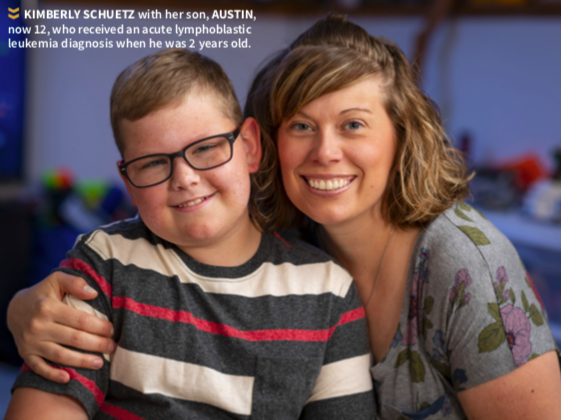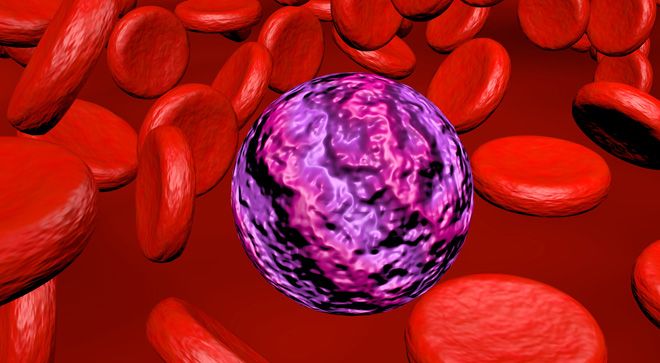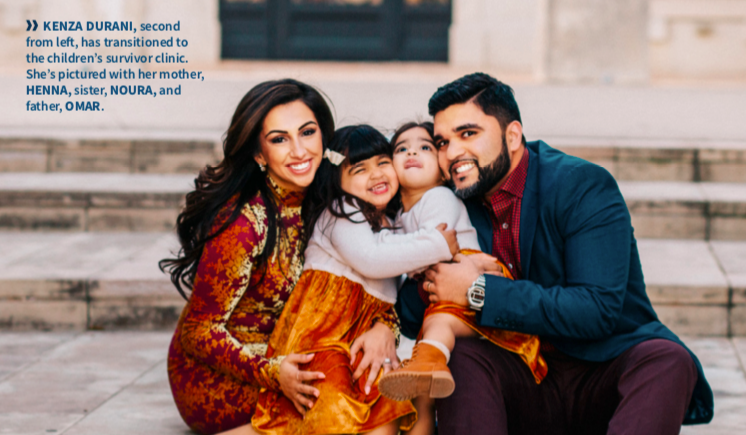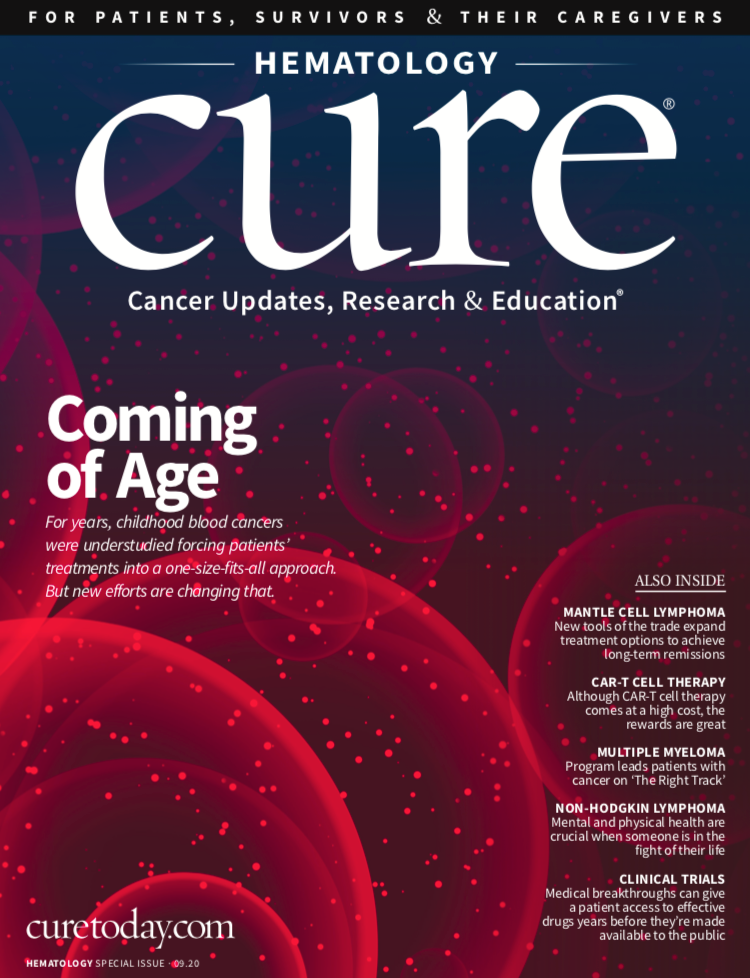Publication
Article
CURE
Coming of Age: New Research Efforts are Improving Treatment of Childhood Blood Cancers
Author(s):
For years, childhood blood cancers were understudied forcing patients’ treatments into a one size-fits-all approach. But new efforts are changing that.
Over Mother’s Day weekend 2011, Kimberly Schuetz took her 2-year-old son on a road trip from their hometown of Fall River, Wisconsin, to visit family in Illinois. Leading up to the journey, Austin had been his normal, energetic self.
“He was eating like a horse and being very active, very playful. No sicknesses, fevers, or anything like that,” Schuetz says.
On Saturday, Schuetz’s father-in-law noticed something alarming while tickling his grandson. One of Austin’s lymph nodes on his neck had swollen to the size of a golf ball. As an oncology nurse, Schuetz immediately had a sick feeling in her stomach. Her mind went straight to thoughts of cancer.
Finding Care
While her gut reaction told her to take Austin to the emergency department, Schuetz decided to wait until Monday to visit his pediatrician back home. After all, her son was acting fine.
A week later, after visits to two pediatricians, the emergency department at their local hospital and pediatric hematologists at a children’s hospital, a bone marrow biopsy confirmed that Austin had acute lymphoblastic leukemia (ALL). A cancer of the blood and bone marrow, ALL is the most common type of cancer that occurs in children.
“I literally felt like I was living somebody else’s life, like I was watching a movie. I remember sitting there and listening to the doctor, but I also felt like I was floating above myself,” Schuetz says. “I was numb and couldn’t cry. Your brain just goes into this state of shock.”
Omar Durani, a family physician in Dallas, Texas, went through similar feelings when his 9-month-old daughter Kenza received an acute myeloid leukemia (AML) diagnosis. In 2016, her swollen lymph nodes signaled to Durani and his wife that something wasn’t right.
“As a physician and dad, it’s kind of difficult to figure out what hat to wear when, and how much to worry about things like that,” he says. “When the swelling worsened, we started advocating for blood work, but all the doctors we visited only kept giving her antibiotics.”
Finally, an emergency department physician who Durani knew personally listened to their concerns and performed blood testing. The results came back with white cell counts through the roof, confirming the family’s worst fears: Kenza had cancer.
Both ALL and AML are treated initially with chemotherapy, and for the vast majority of children, it works. More than 95% of children with ALL and about 85% to 90% of those with AML enter remission after the first phase of chemotherapy. However, remission does not necessarily mean a cure.
Austin relapsed in October 2012 after two phases of chemotherapy, and despite receiving a bone marrow transplant, his ALL came back a third time in May 2013. About 10% to 20% of children with ALL have a disease that relapses or is resistant to treatment. At that point, with no treatment options left, Austin’s parents were told he had three to six months to live.

“We live 45 minutes away from the hospital, and our doctor ended up driving to our house, not to offer any solutions, because we didn’t have a plan, but just to sit and cry with us, because she was so heartbroken and, in such disbelief,” Schuetz says.
Some cancer in children does not respond to chemotherapy. After three rounds of chemotherapy, doctors told Durani that his daughter’s only hope would be a bone marrow transplant. But as a child of Asian descent and mixed ethnic background, Kenza had a less than 2% chance of finding a bone marrow donor match.
While research in adult blood cancers has led to an explosion of new targeted therapies and immunotherapies, such progress has been slower for younger patients. This can leave children such as Austin and Kenza without a path forward. Even for patients who do achieve long-term survival, the lingering toxicity of chemotherapy can lower their quality of life as adults.
“Only four cancer treatments have been approved for first use in children in the last 40 years, compared with hundreds approved for treating adults during this same time frame,” said Dr. Gwen Nichols, chief medical officer of the Leukemia & Lymphoma Society (LLS).
“Out of all the federal funding that goes into cancer research, only 4% goes toward pediatric cancer research,” said Dr. Deepa Bhojwani, director of the Leukemia and Lymphoma Program
at Children’s Hospital Los Angeles in California. “That being said, I would say within the last five to 10 years, there has been a lot more progress in terms of targeted treatment and immunotherapy than there was in the past.”
But the tide may be turning for this young, vulnerable population with new research initiatives dedicated to applying precision medicine to pediatric blood cancers. Much of today’s research in pediatric blood cancers aims to find tailored alternatives to chemotherapy that could prove just as or more effective with fewer harmful side effects.
Giving Children With Blood Cancers Hope
Cancer is still the leading cause of death from disease among children and adolescents in the United States. From 2012 to 2016, leukemia and lymphoma accounted for 38.7% of all cancer types for patients under age 20. Approximately 40% of children with AML and 20% of those with ALL experience a relapse of their disease. Non-Hodgkin lymphoma, the most common type of lymphoma in children under age 14, that is resistant to first-line therapy has a very poor prognosis.
Before joining LLS, Nichols worked for a pharmaceutical company. She says that getting pediatric drugs tested and approved may be difficult because they typically do not bring in as much revenue as adult therapies.
As a result, upon arriving at LLS she was determined to figure out a faster, more efficient way to bring new agents and therapies to children with blood cancers.
In 2016, LLS launched the Beat AML Master Trial for adults with AML. It represented a paradigm shift in the format of clinical trials by testing several different targeted therapies in individual study arms instead of only one drug or combination of drugs at a time. Patients had a genomic screening to determine whether they had one of the genetic mutations that would make them eligible for one of the study arms to test a particular targeted therapy.
“It’s about 50% less expensive to do a master trial than it is to do one drug at a time. So, we needed to do something similar in pediatrics to make it more cost-efficient. But even more than that, if you want to get targeted therapies to kids, you have to have the right kids to test the drug,” Nichols said. “If you’re doing one drug at a time, you have to screen thousands of kids to find the five that fit your drug, which costs time and money.”
In 2019, LLS announced a collaboration with the National Cancer Institute and the Children’s Oncology Group called LLS PedAL (Pediatric Acute Leukemia), a global precision medicine master clinical trial in the same vein as the Beat AML trial. Children with relapsed acute leukemia will undergo genomic screening to match the specific abnormalities driving their cancer with one of several targeted therapies.

As part of The LLS Children’s Initiative: Cures and Care for Children, a $100 million, multiyear effort to take on pediatric blood cancers, LLS PedAL will test multiple agents simultaneously at up to 200 sites worldwide. Trials will follow the same format so that data from multiple institutions can be shared and consolidated.
Nichols and her colleagues hoped to begin the trial this year, but with the coronavirus disease 2019 pandemic, LLS PedAL’s start date has been pushed back to early 2021.
Another inspiring research project is the Pediatric Cancer Genome Project (PCGP), a joint initiative from St. Jude Children’s Research Hospital and Washington University School of Medicine. Since 2010, the two insti- tutions have pioneered efforts to define the genomic landscape of pediatric cancer by sequencing the genomes of normal and cancer cells from 800 patients.
“That work really filled in much of the landscape of mutations that drive ALL, AML and many of the other kinds of pediatric cancer,” says Dr. James R. Downing, president and CEO of St. Jude, who was instrumental in launching the PCGP. “In particular, important fundamental discoveries came out for ALL in terms of new understandings related to the identification of new genetic subtypes, amplifications, fusions and chromosomal translocations of the disease.”
For instance, the PCGP pinpointed genes linked to an ALL subtype with a poor prognosis known as Philadelphia chromosome-like ALL (Ph-like ALL). In 2009, St. Jude scientists were among the first to describe Ph-like ALL in children. Five years later, next-generation sequencing revealed the genetic alterations that give rise to Ph-like ALL, which could be targeted with drugs widely used to treat other types of leukemia more common in adults.
A 2017 study from the PCGP identified potential targets for immunotherapies in pediatric cancers, finding that 88% of leukemias have at least one that could be exploited. A 2018 pan-cancer analysis that examined commonalities and differences among various cancer types, including ALL and AML, suggest that half of the cancers studied may have a targeted treatment available or under development.
“The second phase of the genome project is moving all that technology into frontline diagnostics,” Downing says. “So now we’re getting the whole genome, whole exome and RNA sequencing of every patient, and we gain insight that can be funneled into a protocol that allows them to be treated.”
St. Jude’s frontline ALL protocol includes an unparalleled level of genomic sequencing on the patient, on both cancer and normal cells, which allows physicians to make personalized therapeutic decisions. Downing hopes that collecting such a wealth of data will help usher in new therapies and lead to a further improvement in outcomes.
“So the momentum is there, the studies are ongoing, and hopefully five years from now, we will have a huge variety of therapies to offer our kids instead of just one,” Bhojwani says.
Bhojwani participates in the Therapeutic Advances in Childhood Leukemia & Lymphoma (TACL) consortium, which has its headquarters at Children’s Hospital Los Angeles. TACL brings together children’s hospitals and universities to accelerate the progress of new therapies for pediatric leukemia and lymphoma. The consortium includes 31 institutions in the United States and Australia that collaborate on clinical trials of new drugs and novel therapy combinations in the hopes of expanding the number of treatments available.
Looking Ahead to A Thriving Childhood
Both Kenza and Austin were saved by an experimental treatment called chimeric antigen receptor (CAR)-T cell therapy administered in a clinical trial. It involves engineering the body’s T cells, a type of white blood cell, to produce receptors on their surface called chimeric antigen receptors (CARs). The engineered cells are infused back into the patient, where they can recognize and kill cancer cells.
The Duranis couldn’t find a bone marrow donor match for Kenza, despite having more than 60 donor drives inspired by her diagnosis that registered more than 5,000 new potential bone marrow donors around the country. At that point, they decided to move forward with CAR-T cell therapy coupled with a haploidentical, or partially matched, stem cell transplant in August 2016.

“It was a no-brainer for us since there were no other therapies available besides a standard bone marrow transplant,” Durani says. “Now Kenza’s been in remission for four years, and she’s doing fantastic. She’s a thriving, spunky 5-year-old.”
After his third relapse, Austin’s parents enrolled him in a clinical trial to receive CAR-T cell therapy as a last- ditch effort to save their son. He received the treatment at the beginning of October, and on Halloween – which also happens to be his mother’s birthday – they received the good news that his biopsy showed no traces of cancer.
“I immediately started screaming and crying. I was just elated. It was the best birthday present that I could ever, ever have. Nothing will ever top that,” Schuetz says.
Today, Austin is a typical 12-year-old boy who enjoys video games, swimming with his friends and complaining about household chores. He and Kenza are living proof that innovations such as CAR-T cell therapy give children who have run out of options another chance at life.





